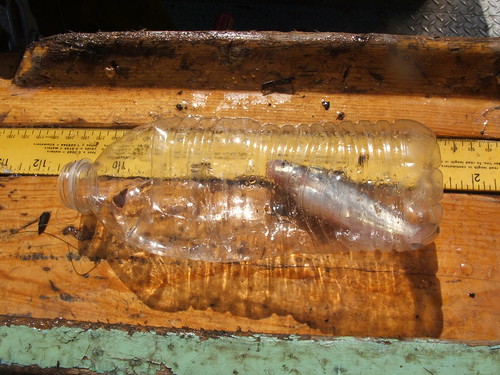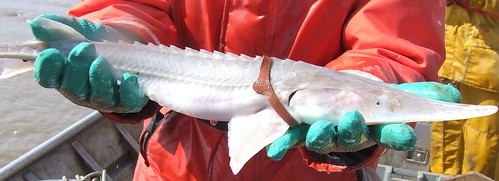When we do a clean-up in the Washington, MO, to St. Louis region of the river, Mo. Dept. of Conservation fisheries biologist Danny Brown usually shows up with his work boat to help haul volunteers. Danny’s a real pro. He knows how to inspire kids, take the opportunity to explain the river as he knows it and make it all look easy.
Danny’s also a world-class wildlife photographer, and you can see and purchase some of his images at www.dannybrownphotography.com. This week he sent us a photo of a shovelnose sturgeon they caught this week while sampling for pallid sturgeon broodstock. Every biologist studying sturgeon and every commercial fisherman I’ve talked to has seen sturgeon caught in rubber bands. As Danny explains below, it’s often a fatal struggle for the fish. Here’s his take on the photo:
__________
Lucky Sturgeon
by Danny Brown, MDC
Here’s an image of a shovelnose sturgeon that my crew recently captured on the Missouri River. Sturgeon and other fish of our large rivers have endured many threats over the years, including habitat loss, pollution, and overfishing, but another challenge they face is litter. If you've never been on the Missouri River you would be amazed at the plethora of items including abandoned boats, washing machines, 55-gallon drums, tires, bottles, cans, and other stuff.
A group of dedicated river rats, called "Missouri River Relief," has tirelessly worked to not only clean up the Missouri River but to instill a sense of ownership in volunteers, especially kids, who turn out to help with the clean-up events. Unfortunately, they can only do so much. For more info, go to: www.riverrelief.org .
Almost every year, as I collect sturgeon from the Missouri River as part of our monitoring efforts, I discover an individual like the one in the attached image. While feeding along the bottom this sturgeon inadvertently swam into a particularly ornery type of refuse -- a rubber band. Once a sturgeon swims into a rubber band, it wears it for life and as the fish grows, the constriction digs into its flesh, not unlike a piece of barbed wire around a tree. By the time we catch the fish, it is often grotesquely deformed near the constriction and in poor condition.
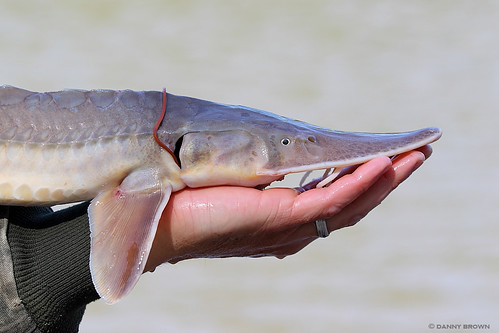 |
| photo by Copyright by Danny Brown |
But instead of sharing a photo of such an unfortunate fish, I'm sharing an image of a healthy fish that was lucky enough to turn up in our gear before its rubber necklace began to tighten. I hope you enjoy the image of this ancient species and you will be happy to know that it was released back to the river, free from the girdling confines of this unwelcome accessory. Thanks to Josh Ward for serving as the hand model for this image.”
_____________
At our clean-up events, we are always proud of the massive trash eyesores we remove from the river. But it’s often the little stuff that proves the most insidious when released into the river environment. Six pack rings that slowly strangle turtles, birds with stomachs stuffed with plastic, or in the case of this little blue catfish, a plastic cave that turns into a death trap (unless you’re lucky enough to then be caught by a helpful biologist).
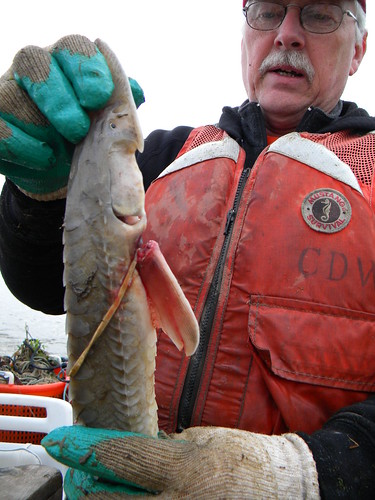 |
| Missouri Master Naturalist Mark Chambers shows a shovelnose sturgeon with a nearly amputated fin due to a rubber band constriction. photo by Steve Schnarr. |
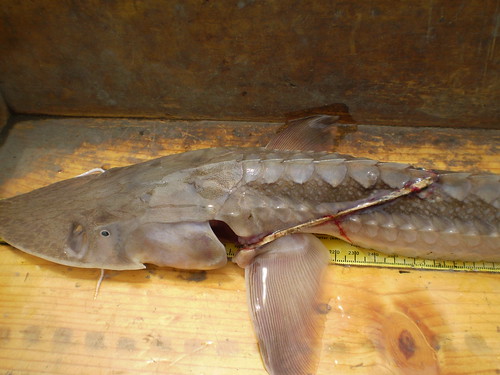 |
| This is another shovelnose deeply impacted by a rubber band. This photo was submitted by Colby Wrasse, US Fish & Wildlife Service. |
